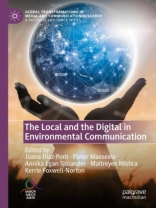This volume interrogates the intertwining of the local and the digital in environmental communication. It starts by introducing a wave metaphor to tease out major shifts in the field, and situates the intersections of local places and digital networks in the beginning of a third wave. Investigations that feature the centrality of place and digital communication platforms show how we today, as researchers and practitioners, communicate the environment. Contributions identify the need for critical approaches that engage with the wider consequences of this changing media landscape, unpacking local and global tensions in environmental communication research. This empirical case study collection from different parts of the world shows that environmental activists and citizens creatively use digital technologies for campaign purposes. It identifies new environmental communication challenges and opportunities, as well as practices, of environmental activists, NGOs, citizens and local communities, in the fight for social and environmental justice.
Innehållsförteckning
1. Environmental Communication in the Intertwining of the Local and the Digital.- Section I Digital Technologies, Place and Environmental Awareness.- 2. Aerial Activism in Old-Growth Rainforest: The Ancient Forest Alliance’s Drone Videography as Spatial Communication.- 3. Employing Digital Technologies in Environmental Communication Campaigns in China: A Capacity-Building Perspective.- 4. The Multiple Airs: Pollution, Competing Digital Information Flows and Mobile App Design in China.- Section II Social Media, Environmental Protest and Community-Building.- 5. Localizing Environmental Conflicts: Facebook Groups as Intertextual Sites for Local Protest Voices.- 6. Surviving the Legacy Media System: The Place of Local Digital Activism in the Chiloé Red Tide Crisis.- 7. ICTs, Environmental Activism and Community Mobilization in Senegal, Kenya and South Africa.- 8. Old Power Struggles and New Media Work: Indigenous Peoples’ Striving for Justice in Contemporary Brazil.- Section III Digital Communication, Environmental Discourse and Local Experiences.- 9. Hacking the Foodscape: Digital Communication in the Co-design of Sustainable and Inclusive Food Environments.- 10. Smart City and the Reinvented Politics of Governing Through Datafied Environment in Songdo, South Korea.- 11. Sparking an Interest in Local Water Issues: Social Media as an Enabler for (Hyper)local Community Engagement in Environmental Issues and the Role of Solution Journalism.- 12. Lived, Local and Everyday: Understanding Media Use in Green Home Renovation.
Om författaren
Joana Díaz-Pont is Lecturer and Researcher at the Department of Political Science and Public Law of the Autonomous University of Barcelona, Spain. Her research is in the intersection between environmental communication, governance and policies for sustainability.
Pieter Maeseele is Associate Professor at the Department of Communication Studies of the University of Antwerp, Belgium. His research agenda focuses on the role and performance of media and popular culture in relation to democratic debate, citizenship and pluralism.
Annika Egan Sjölander is Associate Professor of Media and Communication Studies at Umeå University, Sweden. She researches the democratic role of media and communication in environmental communication and their impact on the development of sustainable societies in the Anthropocene.
Maitreyee Mishra is Assistant Professor at Manipal Institute of Communication, MAHE, India. Her research areas are environmental humanities, development and gender, Japanese anime, and anthropology.
Kerrie Foxwell-Norton is Associate Professor of Communication, Media and Journalism Studies at Griffith University, Australia. Her research explores environmental communication of coastal and marine environments and the myriad of communities therein.












